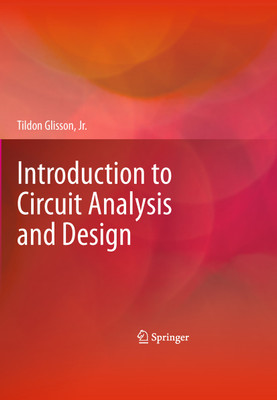Introduction to Circuit Analysis and Design 1st Edition(English, Hardcover, Glisson Glisson)
Quick Overview
Product Price Comparison
Emphasizes input-output descriptions of circuits Emphasizes symbolic relations among currents, voltages, and other quantities Includes topics important in design but not found in competing books Presents more than 800 in-line examples and exercises and more than 1100 end-of-chapter problems Includes sections on methods for checking intermediate and final results Introduction to Circuit Analysis and Design takes the view that circuits have inputs and outputs, and that relations between inputs and outputs and the terminal characteristics of circuits at input and output ports are all-important in analysis and design. Two-port models, input resistance, output impedance, gain, loading effects, and frequency response are treated in more depth than is traditional. Due attention to these topics is essential preparation for design, provides useful preparation for subsequent courses in electronic devices and circuits, and eases the transition from circuits to systems.The differences in depth of treatment arise from a focus on teaching analysis as preparation for design, where the devil is in the details. Introduction to Circuit Analysis and Design gives due attention to differences between physical circuits or devices and circuit or device models, including variation of resistance and capacitance with temperature, variation of resistance with frequency, parasitic and stray capacitance and inductance, residual effects such as leakage resistance of capacitors and winding resistance of inductors, and other such things either not covered or barely mentioned in other books. The treatment of operational amplifiers goes well beyond the ideal model, covering topics such as gain-bandwidth product, slew rate, bias-current compensation, output swing, and power dissipation, all of which must be considered in any realistic design. Where appropriate, chapters conclude with a section that discusses implications for and applications to design. Table of Contents 1. Introduction 2. Current, Voltage, and Resistance 3. Circuit Elements, Circuit Diagrams, and KirchhoffŌĆÖs Laws 4. Equivalent Circuits 5. Work and Power 6. Dependent Sources and Unilateral Two-Port Circuits 7. Operational Ampli?ers I 8. Capacitance 9. Inductance 10. Complex Arithmetic and Algebra 11. Transient Analysis 12. Sinusoids, Phasors, and Impedance 13. Complex Power 14. Three-Phase Circuits 15. Transfer Functions and Frequency-Domain Analysis 16. Fourier Series 17. Operational Ampli?ers II: AC Model and Applications 18. Laplace Transformation and s-Domain Circuit Analysis 19. Active Filters Appendix: Answers to Exercises Index


